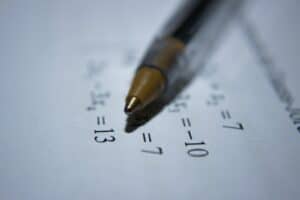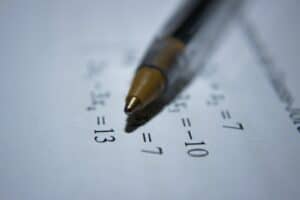The question, “How hard is the GED math test?” is one that frequently preoccupies the minds of individuals preparing to earn their General Educational Development (GED) credential. Mathematics can be a daunting subject for many, and the prospect of tackling a standardized test in this field can be especially intimidating. In this article, we will delve into the intricacies of the GED math test, shedding light on its level of difficulty, the key topics it covers, and strategies to help you prepare effectively.
How Hard Is the GED Math Test?
The GED math test is a key component of the GED exam, which is designed to assess the knowledge and skills typically acquired in four years of high school education. The math test is designed to evaluate the test-taker’s ability to apply mathematical concepts and principles to real-world scenarios.

Many people find the math test to be one of the most challenging parts of the GED exam, and it is known for being particularly difficult for those who struggle with math. However, with the right preparation and study techniques, it is possible to succeed on the GED math test. In this article, we will explore the structure and content of the GED math test, and offer tips and strategies for success.
GED Math Test Content and Difficulty Level
The GED Math test is designed to evaluate the test-taker’s knowledge and skills in basic mathematical concepts. It is divided into two parts, which are taken separately, and the questions are designed to measure proficiency in a range of mathematical skills, from basic arithmetic to algebra and geometry. The test is considered challenging by many test-takers, as it covers a wide range of mathematical concepts and requires careful reading and interpretation of complex problems. The difficulty level of the test varies depending on the test-taker’s familiarity with math, their problem-solving skills, and their overall level of education.
The GED Math test is comprised of two sections: Part 1 and Part 2. Part 1 contains five questions and is focused on basic math skills such as fractions, decimals, percentages, and basic algebra. Part 2 consists of 41 questions and is focused on more advanced mathematical concepts such as algebra, geometry, and trigonometry. Test-takers are allowed 115 minutes to complete both parts of the test.

The GED Math test is designed to assess the test-taker’s ability to solve real-world problems using mathematical concepts. The questions are designed to measure problem-solving skills, mathematical reasoning, and communication skills. Some of the concepts covered on the test include number operations, measurement and geometry, data analysis, and algebraic expressions. Test-takers must be able to read and interpret data presented in various forms, such as tables, charts, and graphs, and use it to solve complex problems.
While some test-takers find the GED Math test challenging, there are many resources available to help prepare for the test. The GED Testing Service provides test-takers with study materials, practice tests, and other resources to help them prepare for the test. Additionally, many community colleges and adult education centers offer GED preparation classes that cover the math test and other subject areas. By utilizing these resources and dedicating time and effort to studying, test-takers can increase their chances of success on the GED Math test.
Factors That Affect the Difficulty of the GED Math Test
The GED Math Test is one of the four subject tests that individuals must pass in order to earn their GED. The GED Math Test is designed to assess a person’s knowledge and understanding of mathematics concepts typically covered in a high school math curriculum.
The GED Math Test consists of two parts, each with their own time limit. The first part contains five questions, and test-takers are given 90 minutes to complete this section. The second part contains 41 questions, and test-takers are given 115 minutes to complete this section.
The GED Math Test covers a wide range of mathematical concepts, including number operations, algebra, geometry, data analysis, and statistics. The level of difficulty of the test varies depending on a variety of factors, including the individual’s math skills, preparation, and comfort with test-taking.
Some factors that can make the GED Math Test more difficult for test-takers include a lack of familiarity with math concepts, difficulty with problem-solving, anxiety or stress, and lack of preparation or study time. Additionally, the GED Math Test includes a calculator-allowed section and a calculator-prohibited section, and test-takers must be proficient with the use of a calculator in order to complete the test successfully.
Despite the potential difficulty, with adequate preparation and study, individuals can overcome these obstacles and successfully pass the GED Math Test. It is important to approach the test with confidence, practice test-taking strategies, and utilize available resources to improve your math skills and knowledge.
Strategies for Success on the GED Math Test
The GED math test can be challenging for many test-takers, but there are a variety of strategies that can help you to succeed. Here are some tips to help you prepare for and do your best on the GED math test:
- Familiarize yourself with the test format and content: The GED math test is divided into two parts, each of which consists of 25 questions. The first part covers basic arithmetic, algebra, and geometry, while the second part covers more advanced algebra and functions. By reviewing the test content and format beforehand, you’ll have a better idea of what to expect and can prepare more effectively.
- Practice with sample questions and tests: To gain confidence and experience, it is important to practice with sample questions and tests. The GED Testing Service provides a range of free resources, including sample test questions and practice tests that simulate the real test-taking experience. By practicing with these materials, you can identify your strengths and weaknesses and work on improving your skills.
- Review math concepts and formulas: It is important to have a solid understanding of the math concepts and formulas covered on the GED math test. Reviewing these concepts and formulas can help you to solve problems more quickly and accurately. You can find math review materials online, in books, or by taking a GED math prep course.
- Manage your time: The GED math test is 115 minutes long, which means you have an average of 1.3 minutes to answer each question. To manage your time effectively, you should set a pace that allows you to complete all the questions within the allotted time. If you get stuck on a difficult question, move on to the next one and come back to it later if you have time.
- Use estimation and approximation: Estimation and approximation can be helpful tools for solving problems quickly and efficiently. By estimating or approximating the answer to a problem, you can narrow down the possible choices and eliminate unlikely options.
- Check your work: When you have completed a problem, always check your work to ensure that your answer is correct. This can help you catch any mistakes you may have made and can boost your confidence in your ability to solve similar problems.
By following these strategies, you can improve your chances of success on the GED math test. With practice and preparation, you can develop the skills and knowledge you need to pass the test and earn your GED credential.
The Importance of Practice Tests for GED Success
Unlocking Success through Practice
Embarking on your GED journey involves more than just reviewing textbooks and class notes. It’s about practical application, and that’s where practice tests become your invaluable allies. Taking GED practice tests provides a dynamic way to assess your understanding of the material and pinpoint areas that need more attention. These simulated exams mimic the actual testing environment, offering a glimpse into the format, timing, and question types you’ll encounter on the real day. By integrating regular practice tests into your study routine, you enhance your test-taking skills and build the confidence needed to tackle the GED math test effectively.
Turning Mistakes into Learning Opportunities
When it comes to preparing for the GED math test, viewing mistakes as stepping stones to success is key. Practice tests highlight areas where you may stumble, allowing you to delve deeper into the underlying concepts. Instead of seeing a low score as a setback, consider it a roadmap for improvement. Analyze the questions you got wrong, understand the reasoning behind the correct answers, and use this insight to refine your study strategy. The goal is not just to memorize solutions but to comprehend the underlying principles, turning each practice test into a personalized learning experience that propels you toward GED success.
Strategic Study Approaches for GED Math

Tailoring Your Study Plan to GED Math
As you embark on your GED math test preparation, adopting a strategic study plan tailored to the test’s content is crucial. Begin by identifying your strengths and weaknesses within different mathematical concepts. Devote more time to areas where you feel less confident, ensuring a balanced approach that covers the breadth of topics. Utilize online resources, textbooks, and GED prep courses to reinforce your understanding of key concepts. Consider breaking down your study sessions into focused blocks, concentrating on specific topics during each session. This targeted approach allows for deeper comprehension and a more efficient use of your study time.
Real-world Applications
The GED math test is not just an assessment of theoretical knowledge; it evaluates your ability to apply mathematical concepts to real-world scenarios. Enhance your study experience by incorporating real-world applications into your learning process. Explore how mathematical principles are utilized in everyday situations, from budgeting and finance to measurements and problem-solving. This practical approach not only solidifies your understanding of abstract concepts but also equips you with the skills needed to tackle the diverse challenges presented in the GED math test. Connecting theory to practical applications transforms your study sessions into engaging experiences that bridge the gap between classroom learning and real-life problem-solving.
Preparing Mentally for the GED Math Test
Success on the GED Math test not only relies on a solid understanding of mathematical concepts but also on mental preparedness. Many test-takers experience anxiety or stress when faced with standardized tests, and the GED Math test is no exception. To overcome this challenge, consider incorporating mindfulness and relaxation techniques into your preparation routine. Practice deep breathing exercises or meditation to calm your nerves and enhance focus. Additionally, visualize yourself confidently tackling math problems during the test, reinforcing a positive mindset. By addressing the mental aspect of test-taking, you can approach the GED Math test with increased confidence and a clearer head, ultimately improving your performance.
Utilizing Technology in GED Math Preparation
In the age of technology, leveraging digital resources can significantly enhance your GED Math test preparation. There are various apps, online platforms, and interactive tools specifically designed to reinforce mathematical concepts. These resources offer a dynamic and engaging way to practice different math skills, from basic arithmetic to more complex algebraic equations. Furthermore, explore virtual study groups or forums where you can discuss challenging problems with peers or seek guidance from educators. Integrating technology into your preparation not only adds an interactive element but also allows for flexibility in your study schedule. Embracing these digital tools can be a game-changer, providing a modern and effective approach to mastering the content.
